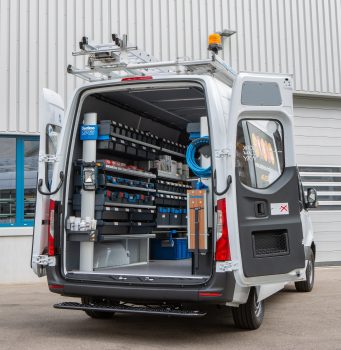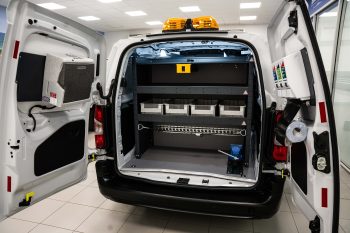Choosing the right accessories and storage solutions for van fleets is not an easy task. Thankfully, there is plenty of help at hand to ensure vehicles are fit(ted) for purpose. By Matt MacConnell.

Many companies rely on their van fleet to lug gear around for multiple daily jobs. So it’s vital that LCV operators optimise and maximise vehicle storage to keep tabs on what fixtures, fittings and equipment are needed for a particular job. A messy van can lead to a fogged mind, which can result in missing fundamental parts that are needed to get a job done.
When it comes to van outfitting, there are lots of market options available for fleets on tight budgets, for those wishing to make best use of the space available and for businesses who use more specialised machinery.
Using lightweight storage containers and racking material could help improve fuel economy by lowering the van’s overall weight. It could also increase the driving range of fleets that use electric LCVs. With this in mind, Sortimo offers a lightweight aluminium system called SR5. Fleet managers can also design labels for storage boxes, foam inserts for equipment – and build a modular system that can be rearranged, depending on the operator’s needs.
Sortimo has partnered with various companies, such as Bosch and Gedore, which means that Bosch power tools can be stored correctly in the Sortimo LBOXX, a storage container designed to fit into the racking system. Sortimo also offers its FlexRack 2.0 shelving system adapted for delivery companies. This system is mounted to a van’s interior walls and can be folded down to allow for parcel deliveries, or retracted for larger objects that take up most of the van’s floor space.
See the light
Meanwhile, the Elite Plus solution offered by Bri-Stor Systems contains lightweight steel and can integrate various configurable storage components. Like the Sortimo system, the Elite Plus is modular and Bri-Stor claims it can be fitted into any LCV on the market. The company also offers EasiLoad, which is designed to make LCV ladder roof storage and access easier. This system is offered in lengths of 2.4m, or 3.2m for longer ladders – and either a single or double format.

Various companies offer template fitting services that can be tailored to a particular van size. These fittings are predesigned and can be handy for companies that specialise in a particular area, such as mobile paint shops or mobile field surveys. Other fleets who could benefit here are those who require accommodation vans, mobile workshops and small vehicle transport, or large fleets that require all vans to be decked out the same way. Having a template installed could reduce the amount of time that a van is off the road for fitting, as no design work is required.
Small details
Planning van outfitting can be a challenge, but it’s important not to forget smaller accessories that may be crucial – for example, a medical kit. Many outfitters who produce modular systems often offer first aid kits, eye wash stations, fire extinguishers or a hand washing station that can be attached to the racking. Fleet managers can also choose from other accessories such as hand gel dispensers, bins, glove dispensers, wheel arch boxes (making the most of wasted wheel arch space), 20-litre fuel can holders and gas cylinders.
Drivers who lift heavy loads in and out of an LCV may require a hoist or crane to be fitted. Here, there are a few options on the marketplace – and these can occasionally be an additional accessory when outfitting an LCV, depending on the supplier. A common crane option is the free-standing jib crane that is mounted to the floor of the LCV. These cranes can be operated via the vehicle’s 12v or 24v power supply and can lift a maximum of 250kg. Businesses that need to lift upwards of that weight can use a frame-mounted crane. These are often mounted to four posts that are installed on the outer edges of the LCV’s interior, which means it won’t take up too much room. They can have a reach of over 3.6m, depending on which
option is chosen and can easily lift 500kg. When it comes to interior and exterior LCV lighting, most will run off the van’s power supply, although there are some rechargeable or battery-operated options available. Lighting a van’s interior will not only help the fleet operator find the specific tool or component they need, it will also improve operational safety. Some lighting systems are automatic and triggered either by a motion sensor or whenever the van’s rear doors are opened. Exterior lighting – such as strobe beacons, light bars and rear or side work lights – can be mounted to an LCV’s roof and operated from a switch box in the cabin.
Power-related products
Other available accessories are powered side and rear step systems. Whenever a van door is opened or closed, the step will respectively fold out or retract automatically. A van with many powered accessories may cause rapid battery discharge, which isn’t ideal if you have components or power tools that need regular charging. However, roof-mounted solar panels are available that will charge a secondary battery. If a fleet opts for solar panels, a charge controller may be required to regulate the voltage. This controller will help charge the batteries efficiently and prevent any overcharging. Companies that need power on site can use accessories such as an all-in-one power unit, which provides 240v power even when the van is turned off, a split-charge system which helps protect your van’s starter battery when the van is no longer idling, power inverters and 110v transformers.
As of February 2023, reported tool theft incidents in London went up by 25% in comparison to 2022 figures, according to research carried out by Herts Tools. Powered hand tools remain a target, with 22,005 such items stolen between January and October 2022. Non-powered hand tools such as garden implements, building materials, ladders, steps and trestles are the next most popular target, accounting for 1,683 thefts in the same period.
Many suppliers allow fleet operators to take their vans home after their shift, which means they aren’t under constant depot surveillance (something that could be enough to deter thieves). Fitting vans with deadlocks may slow down a thief, while trackers may help retrieve whatever is left of a stolen van and its equipment. If the thief’s intent is to steal expensive power tools, adding a Sold Secure or Police-verified lockbox to a van should slow down the process or stop the thief in their tracks. There are various lockbox options available which cover pipe storage, battery storage, ion battery charging units, toolboxes, strimmer and chainsaw storage and dangerous chemical storage. Some companies also offer portable lockboxes.

